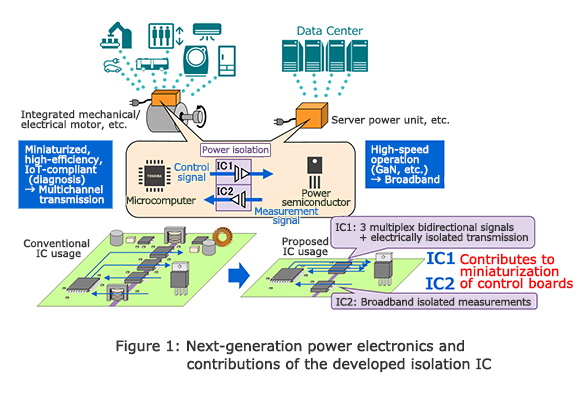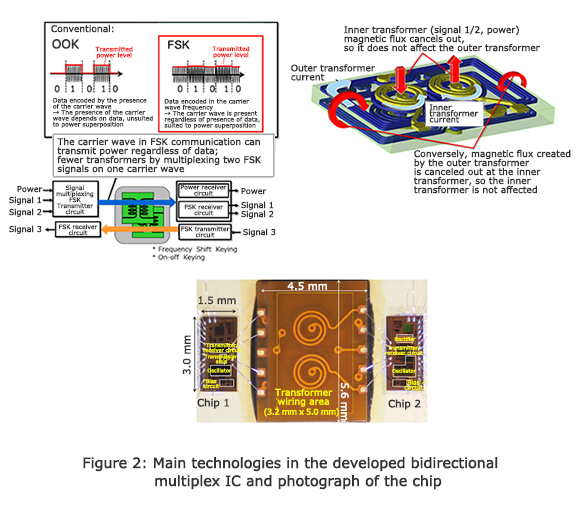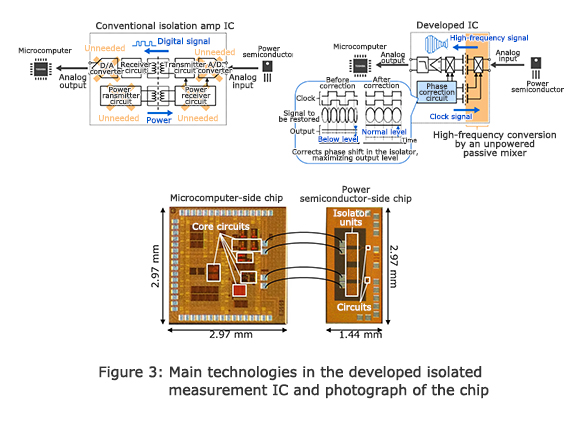Toshiba Develops an Electromagnetic Coupling-type High-speed Isolation IC for Next-generation Power Electronics Systems
-Isolated multiplex transmission of multiple signals and power in a single package at low cost contributes to miniaturization, weight reduction, energy savings, and higher reliability of power electronics systems-
Toshiba Corporation
TOKYO─Toshiba Corporation (TOKYO: 6502) has developed a bidirectional multiplex transmission IC, which is the world's first single-package IC, produced by generic manufacturing processes, to achieve bidirectional communication of three signals and power transmissions exceeding 100mW. Applications of this isolation IC supports electric mobility and miniaturization in various motor systems. This is one of the two isolation ICs for realizing next-generation power electronics systems that are compact, energy-saving, and highly reliable. The other is a high-speed isolated measurement IC that can be installed in power supply systems for servers in data centers that require high-speed operations. Toshiba presented this technology on February 18, 2020 at the 2020 IEEE International Solid-State Circuits Conference in San Francisco.
Power electronics systems are indispensable for power conversion and control, and are installed in electrical appliances, electric mobility applications and industrial equipment. The increasing demand for miniaturization and weight reduction of power electronics systems, along with its energy savings and high reliability features are important factors for contributing to a sustainable future.
The electrification of mobility applications and the expanding robotics industry have increased the demand for smaller and lighter power electronics systems. This can be realized by reducing the size and weight of drive inverters and integrating them with motors. There is also a growing need to protect power electronics systems using IoT.
In addition, Society 5.0 and Industry 4.0 are pushing the growth of an information society and energy-efficient data centers. Research is currently conducted on the use of high-speed semiconductors manufactured from GaN(Note 1) and other new materials. This is to improve the efficiency of server power supplies, which accounts for about 15% of electricity consumption in energy-intensive data centers.
The isolation of the high-voltage parts used in power electronics is critical to protect control systems operating at lower voltages and for user's safety. Conventionally, photocouplers(Note 2) and discrete transformers have been widely used for communication and power transmission between low and high voltages. However, to be compact, lightweight, energy-efficient equipped with IoT compatibility, a single-package isolated IC without additional external components to enable a wide range of signals is required. This IC also has to be capable of bidirectional transmission of multiple signals and power for driving power semiconductors. Toshiba estimates the world market value of electromagnetic coupling-type high-speed isolation ICs as approximately 100 billion yen.
To meet these needs, Toshiba has developed two electromagnetic coupling–type isolated ICs; bidirectional multiplex transmission IC and high-speed isolated measurement IC.
The main feature of the bidirectional multiplex transmission IC is to isolate power semiconductors in drive circuits. Conventional drive circuits each require one IC to transmit and receive multiple signals, making size and weight reductions difficult. However, Toshiba has successfully reduced the number of ICs by sharing signal and power transformers through the world's first application of the FSK(Note 3) wireless communication method in an isolated IC. The device structure cancels magnetic fields generated by adjacent transformers, eliminating the need for a large separation distance and enabling miniaturization. In addition, a clock synchronization circuit between isolators supports reliable operations without the need for a high-precision external oscillator(Note 4), which is conventionally required for FSK communication.
This bidirectional multiplex transmission IC is the world's first single-package IC, developed by generic manufacturing processes, to achieve bidirectional communication of three signals and power transmissions exceeding 100mW. Applying this IC to an inverter control board can reduce the footprint of the isolated part by about 35%.
Another development is a high-speed isolated measurement IC that can be installed in power supply systems for servers in data centers that require high-speed operation. This isolated measurement IC can measure high-voltage, high-frequency current up to 35 MHz, making it suitable to control measurements in high-efficiency power supply devices using high-speed GaN and other power semiconductors. Applying an unpowered passive mixer(Note 5) circuit used for wireless communication allows omission of the large external isolated power transmission circuit that is conventionally required. In addition, a dedicated calibration circuit improves transmission accuracy. This enables measurements more than 300 times faster in a single-package IC, while also reducing the footprint by about 70% as compared with conventional methods capable of similar high-speed measurements.
Toshiba considers power electronics to be a new growth business and will continue to develop ICs and systems applying these technologies to contribute to the improvement of various power systems.



- (Note 1)
- GaN
GaN (gallium nitride) semiconductors have lower resistance when power is turned on in comparison with silicon semiconductors. Replacing conventional diodes and transistors in AC/DC converters with GaN devices reduces power loss and allows for smaller transformers. - (Note 2)
- Photocoupler
A component that transmits isolated signals by converting electric signals into light, then internally converting them back into electric signals. - (Note 3)
- FSK (frequency-shift keying)
A modulation method for communication in which information is encoded in the frequency of the carrier wave. - (Note 4)
- Oscillator
A component for outputting a signal with a constant frequency. Generally, ceramic or crystal oscillators are used. - (Note 5)
- Passive mixer
A circuit that converts measured signals to a high frequency using only a clock signal, thereby allowing isolated transmission without power transmission.


